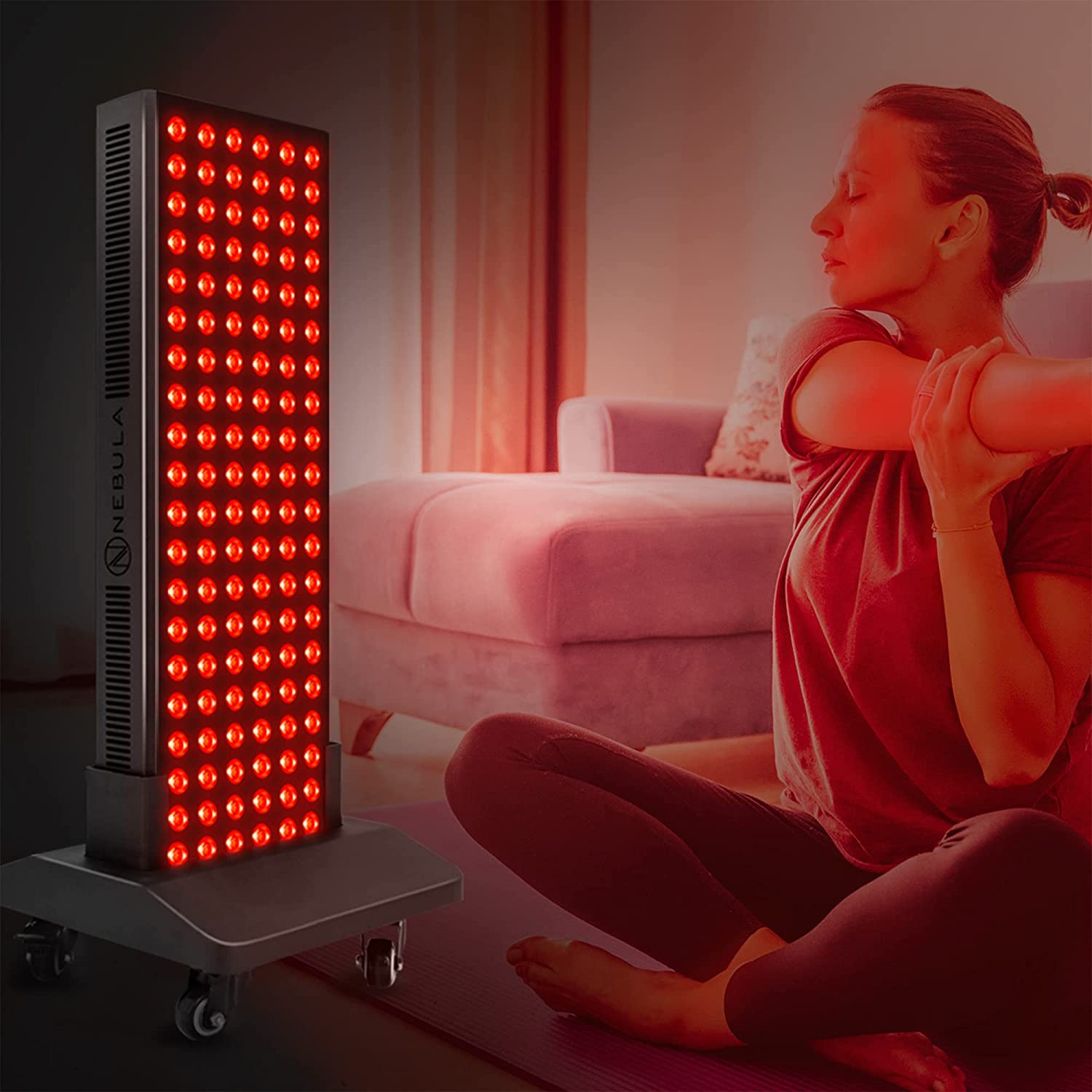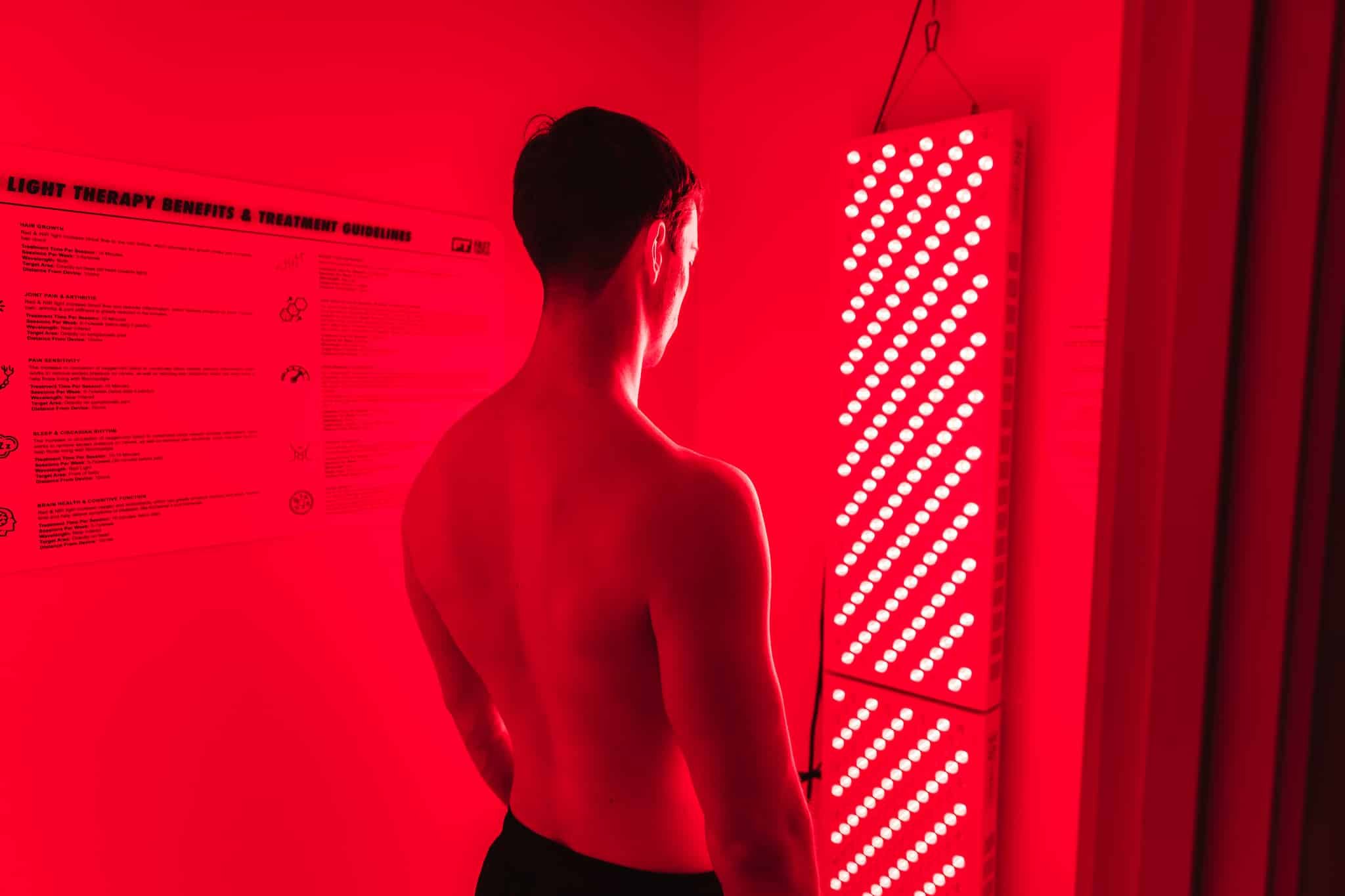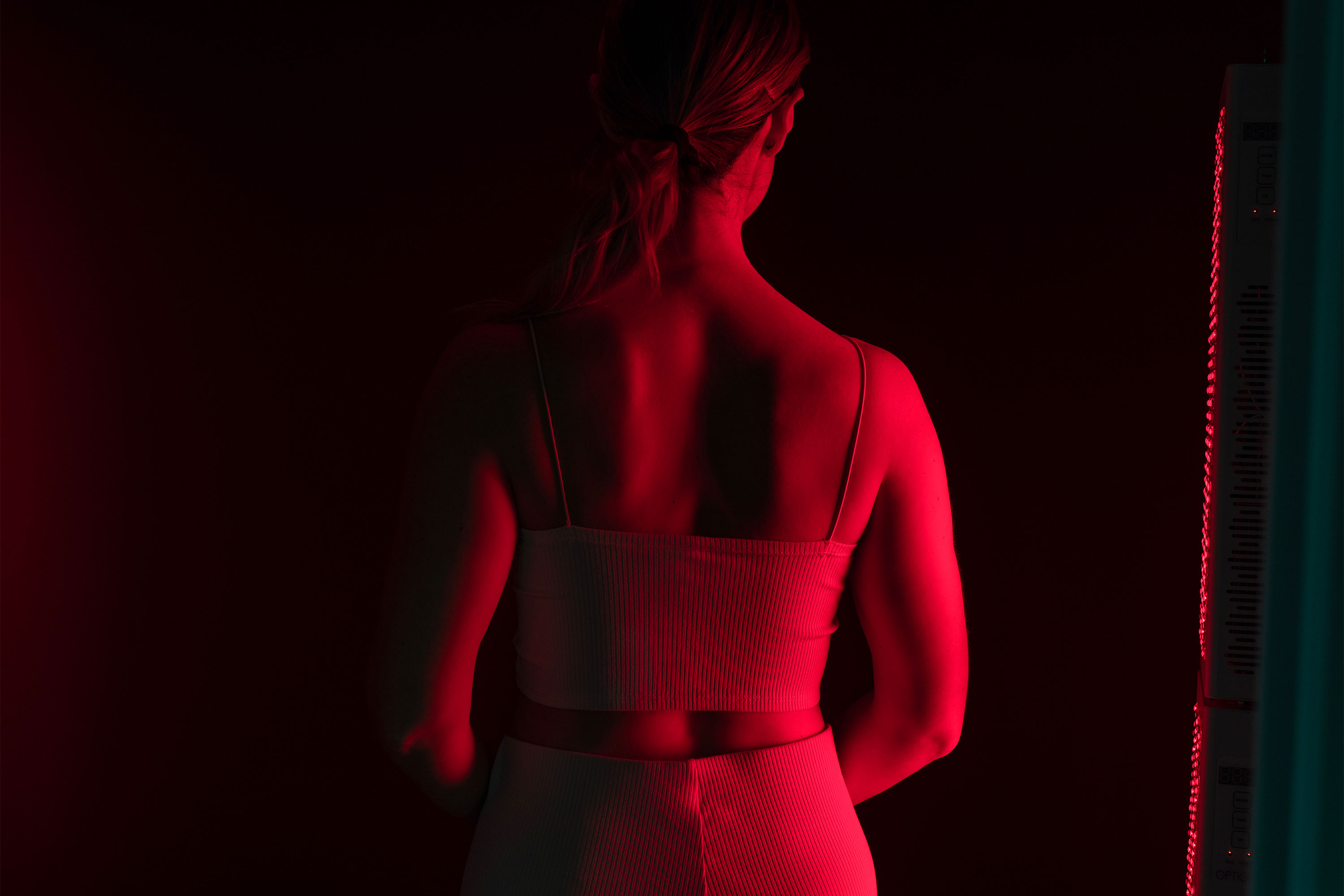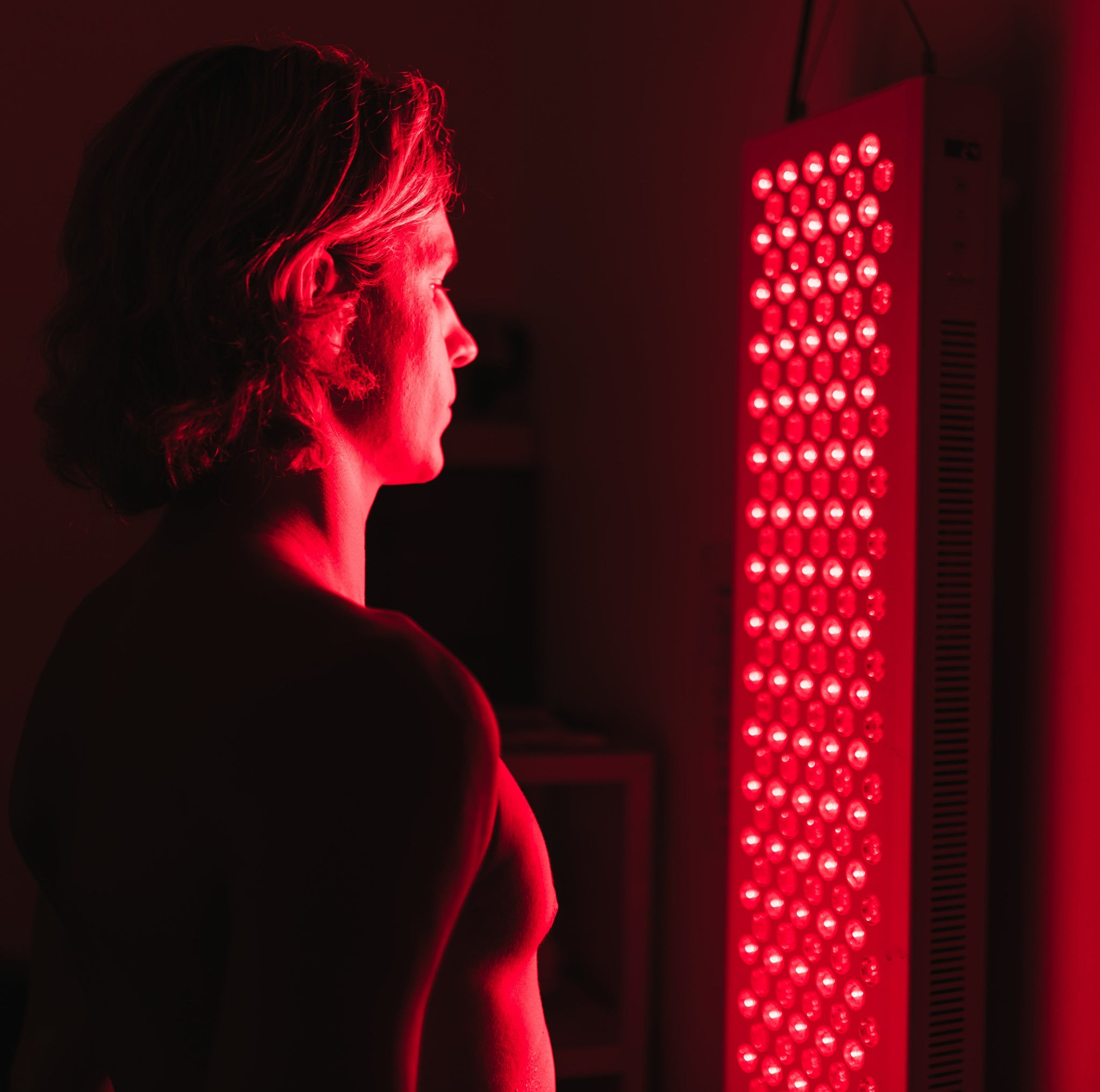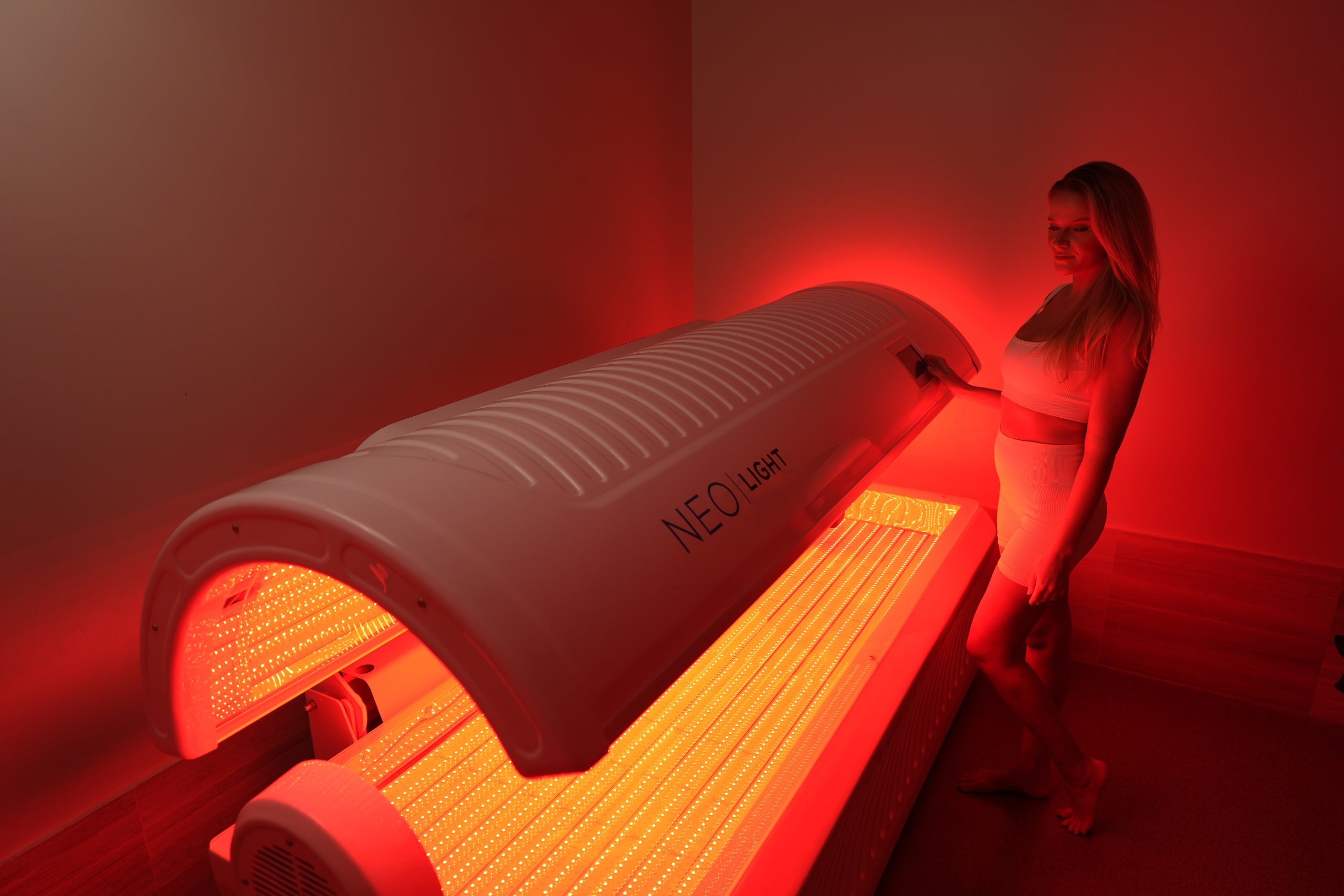
In recent years, red light therapy has gained popularity as a non-invasive and versatile treatment with a range of potential benefits for both physical and mental well-being. From promoting skin health to aiding muscle recovery, the advantages of red light therapy are diverse and scientifically supported.
This article explores the multifaceted benefits of red light therapy, shedding light on its various applications and the underlying mechanisms that make it an increasingly sought-after option for holistic health.
What Is Red Light Therapy?
It has been shown that red light therapy (RLT) is effective in reducing the appearance of fine lines and wrinkles, as well as redness, acne, and scarring. More clinical studies are required, according to several experts, to verify its efficacy as a therapy. Consult your doctor to see whether red light treatment is appropriate for your skin condition.
In 2023, the worldwide light therapy market had a valuation of $621.1 million, and it is anticipated to attain $802.7 million by 2031, with a compound annual growth rate (CAGR) of 4.4% expected from 2023 to 2031.
How Does Red Light Therapy Work?
To engage in red light treatment, one must subject their skin to a red-light emitting bulb, gadget, or laser. Mitochondria, sometimes known as the "power generators" of the cell, take it in and use it to create additional energy. Some researchers have hypothesized that this promotes cellular renewal and wellness. This promotes the repair of damaged skin and muscle.
Red light treatment does not cause any harm to the skin since it does not generate a lot of heat. This is not the same light that is used in tanning salons; it will not do any harm to your skin.
Is Red Light Therapy Effective?
Most specialists are still determining whether RLT works for all its stated purposes. Most agree the trials released thus far indicate promise for specific illnesses, but further research is needed. Red light therapy is a new treatment gaining popularity. There needs to be more proof for most usage.
Randomized, placebo-controlled trials are the best way to evaluate a product. This implies a specific number of participants with the same age, weight, race, gender, etc., get either the study therapy or a placebo (false or “sham” treatment) for the same illness.
Other typical treatments are compared in specific research. The new therapy may be compared to a placebo or “current standard” treatment.
Many RLT research had a tiny sample size, no placebo group, were animal studies, or focused on cell tissue. Many academics think early findings are encouraging, but additional quality trials with more significant populations are required.
Physical Benefits Of Red Light Therapy
Although the Food and Drug Administration has given its stamp of approval to certain red light devices, these are generally categorized as class 2 devices; this means that while there is evidence to support their use in certain health conditions (which we'll discuss in this section), they are not currently regulated sufficiently to guarantee the effectiveness or safety of any particular device.
Consult your physician before purchasing red light therapy equipment or deciding whether this treatment method is good for you.
Skin Quality
A combination of red and infrared LED light therapy was shown to be effective in treating skin disorders in a trial including 31 participants. They exhibited reduced sun-induced aging and wrinkles.
A 12-week course of daily red light therapy dramatically reduced wrinkles around the eyes in a randomized controlled trial (DB-RCT) with 52 female patients.
A similar research found that middle-aged people who used LED treatment for sunspots saw improvement. Acne was better treated with red light than infrared light in a randomized controlled trial with a single blind.
In a randomized controlled trial (RCT), 107 individuals with acne were given either blue light alone, benzoyl peroxide, or a combination of the two. An RCT including 136 people found that red light treatment also substantially improved skin color, roughness, and collagen density.
However, red light promoted some features of skin scarring in human cells. These features include reactive oxygen species and the suppression of collagen production.
Wound Healing
Twelve dental patients were subjected to a randomized, controlled trial that found red light treatment accelerated recovery time after oral surgery. However, it did not alleviate pain.
Red light treatment was shown to be effective in reducing diabetic foot ulcer size and discomfort in a randomized controlled trial including 16 individuals with diabetes.
Another randomized controlled trial involving 30 diabetic patients found similar outcomes; the addition of red light treatment to standard care decreased ulcer size more than standard care alone.
Red light dramatically accelerated wound healing and outperformed infrared treatment for burn wounds in a diabetic rat model of skin wound and burn damage. Healing of incision wounds was accelerated, and infection was minimized in diabetic rats exposed to red light.
Red light therapy for rabbits with skin wounds accelerated recovery more than blue light therapy or no treatment. It boosted cellular and tissue development.
Inflammation
Red light treatment is often used to reduce inflammation.
Inflammatory cytokines (TNF-a, IL-1A, and IL-6) are downregulated in response to red light treatment, which in turn inhibits the inflammatory response and decreases oxidative damage.
A review on muscle healing (in animal models) indicated that red light treatment could decrease inflammation, favourably affect growth factors, and promote blood vessel development.
Pain
Red light substantially decreased self-reported pain in research (DB-RCT), including 80 individuals undergoing chemotherapy. Although one randomized controlled trial (RCT) suggested that red light treatment for tennis elbow was effective, more research is needed.
The research on persistent low back pain needs to be more consistent. After spinal cord damage, red LED treatment alleviated discomfort and increased mobility in mice.
Cognitive Function
Stroke, Alzheimer's disease, Parkinson's disease, depression, and cognitive improvement in healthy patients are just a few of the many illnesses researched using red light treatment.
Memory, focus, and executive function were all enhanced by red and near-infrared light treatment in a randomized controlled trial (RCT) including 11 people with dementia.
Red light treatment was shown to reduce symptoms of sadness, anxiety, headache, and sleeplessness in a single case study. Meanwhile, their mental health and overall well-being began to rise.
TBI patients may potentially benefit from red light treatment to restore brain function. In two case studies, red light treatment enhanced memory and concentration and even decreased PTSD in one patient.
Rats exposed to red light had more stable levels of inflammatory markers, including IL-1, TNF-, and IL-6, and it also protected cells from dying. For up to four weeks after a head injury, this treatment improved cognitive performance.
Hair Growth
Androgenic alopecia, or female pattern baldness, was treated with red light treatment twice weekly for 17 weeks in a randomized controlled trial.
Red light therapy twice weekly for 16 weeks resulted in a statistically significant increase in hair follicles compared to placebo in a randomized controlled trial (DB-RCT) of 41 males. Reviews on alopecia and hair loss indicated red light treatment was safe and beneficial for both men and women.
The expansion of the global light therapy market is primarily fueled by the escalation in skin disorders and the growing number of individuals afflicted with depression, which represent emerging trends in the light therapy market.
Mental Health Benefits Of Red Light Therapy
Red light treatment is another area of medicine that seems like something from the distant future. But in reality, it's a tried-and-true "pod" technology that combines many treatments (such as lasers and light therapy) into one simple, painless procedure. You may even purchase smaller red light treatment equipment to use immediately at home.
Red light treatment has been shown to reduce joint and muscular pain by reducing chronic (ongoing) inflammation. Some advantages and outcomes of red light therapy are described below.
Emotional Well-being And Mood Enhancement
Red light therapy is emerging as a potential ally in fostering emotional well-being. Exposure to specific wavelengths of light has been linked to the release of endorphins, the body's natural mood lifters.
This suggests that regular sessions of red light therapy contribute to an uplifted mood and an overall sense of emotional balance.
Stress Reduction And Cortisol Modulation
In our fast-paced lives, stress is a prevalent concern impacting mental health. Red light therapy appears to play a role in stress reduction by modulating cortisol levels—the hormone associated with stress.
By promoting a more balanced cortisol response, red light therapy may offer individuals a non-pharmacological tool for managing stress and preventing its adverse effects on mental well-being.
Neurotransmitter Modulation For Anxiety Relief
Studies suggest that red light therapy may influence neurotransmitter activity in the brain, particularly serotonin and gamma-aminobutyric acid (GABA). These neurotransmitters play a crucial role in mood regulation, and their modulation could contribute to anxiety relief.
For individuals dealing with the challenges of anxiety disorders, incorporating red light therapy into their routine may provide a complementary approach to traditional interventions.
Circadian Rhythm Alignment For Improved Mental Health
The body's internal clock, or circadian rhythm, plays a vital role in mental health. Disruptions to this rhythm can lead to mood disorders and cognitive disturbances. Red light therapy has shown promise in aligning circadian rhythms, mainly when exposure occurs during specific times of the day.
This alignment may contribute to better mental health by optimizing the body's natural biological rhythms.
Brain Health And Neuroprotection
Beyond its immediate effects on mood and stress, red light therapy has implications for long-term brain health. Research indicates that it may have neuroprotective effects, potentially reducing the risk of neurodegenerative conditions.
This aspect adds a layer of significance to red light therapy as a holistic approach to mental health, focusing not only on symptom relief but also on preserving cognitive function over time.
Red Light Therapy Usage In The Sports And Fitness Industry
Laser Therapy released research that tracked a group of collegiate players to see how long it took for them to go back on the field after an injury. A total of 65 of them benefited from LED light treatment for their wounds.
The average RTP for these participants was 9.6 days, whereas the average prediction was 19.23 days. LED phototherapy substantially and safely lowered the RTP in committed university athletes across a spectrum of injuries with no side effects, the study authors reported.
Enhancing Athletic Performance
Athletes and fitness enthusiasts are turning to red light therapy as a tool to enhance their performance. The therapy's ability to stimulate cellular energy production and reduce muscle inflammation can contribute to improved endurance, faster recovery times, and overall better athletic outcomes.
As a non-invasive and easily accessible intervention, red light therapy is gaining traction in the competitive world of sports.
Accelerating Muscle Recovery
One of the critical applications of red light therapy in the sports industry is its role in muscle recovery. After intense workouts or competitions, muscles often require swift recovery to maintain peak performance.
Red light therapy's impact on cellular repair mechanisms and reduction of oxidative stress can aid in faster recovery, allowing athletes to train more consistently and with reduced risk of overuse injuries.
Reducing Delayed Onset Muscle Soreness (DOMS)
Delayed Onset Muscle Soreness (DOMS) is a common challenge for athletes and fitness enthusiasts. Red light therapy has shown promise in mitigating the intensity and duration of DOMS.
By modulating inflammation and promoting the release of endorphins, red light therapy provides a non-pharmacological approach to managing post-exercise muscle soreness, allowing individuals to return to training more quickly.
Optimizing Pre-Workout Warm-up
Incorporating red light therapy into pre-workout routines is gaining popularity as a means to optimize warm-up sessions.
The therapy's ability to improve blood flow and increase oxygenation of tissues may enhance muscle flexibility and reduce the risk of injuries during physical activity. As a part of a comprehensive warm-up strategy, red light therapy offers a non-invasive and efficient way to prepare the body for optimal performance.
Supporting Joint Health And Flexibility
Joint health is paramount for athletes, and red light therapy's anti-inflammatory properties make it a valuable tool in supporting joint function. Regular sessions of red light therapy may contribute to reduced joint pain and increased flexibility, providing athletes with the mobility needed for various sports and fitness activities.
This aspect of the therapy aligns with the holistic approach to overall physical well-being in the sports industry.
Medical Applications Of Red Light Therapy
Chronic Pain Management
Red light therapy is gaining recognition as a non-pharmacological intervention for chronic pain management. Its ability to reduce inflammation and modulate pain signalling pathways makes it a valuable option for individuals dealing with conditions such as osteoarthritis, fibromyalgia, and neuropathy.
The therapy's non-invasive nature positions it as a potential alternative or complementary approach to traditional pain management strategies.
Wound Healing And Tissue Repair
In the realm of medical applications, red light therapy shines as a tool for wound healing and tissue repair. By stimulating cellular activity and promoting the production of collagen, the therapy accelerates the healing process.
This has practical implications in medical settings, where promoting efficient wound closure is crucial for preventing infections and minimizing scarring.
Dermatological Disorders
Beyond cosmetic benefits, red light therapy has demonstrated efficacy in treating certain dermatological disorders. Conditions such as psoriasis, acne, and eczema may see improvement through the therapy's anti-inflammatory effects and promotion of skin cell regeneration.
Dermatologists are increasingly incorporating red light therapy into their treatment plans for these conditions, offering patients a non-invasive and well-tolerated option.
Management Of Temporomandibular Joint (TMJ) Disorders
Temporomandibular joint disorders can cause significant pain and dysfunction in the jaw. Red light therapy's anti-inflammatory properties and ability to reduce muscle tension make it a potential adjunctive treatment for individuals with TMJ disorders.
The therapy's application to the jaw area may contribute to pain relief and improved jaw function in those experiencing TMJ-related symptoms.
Neurological Conditions And Cognitive Function
Exploring the impact of red light therapy on neurological conditions opens up new possibilities in medical applications. Some studies suggest that the therapy's influence on mitochondrial function and neuroplasticity could be beneficial for conditions such as traumatic brain injury, stroke, and neurodegenerative diseases.
While more research is needed, the potential for red light therapy to support cognitive function and neurological recovery is an area of growing interest in medical research.
Oral Health And Periodontal Treatment
Red light therapy's antimicrobial properties and ability to reduce inflammation make it a noteworthy candidate for oral health applications. In periodontal treatment, the therapy may aid in reducing inflammation, promoting tissue repair, and managing bacterial growth.
Integrating red light therapy into oral health care protocols showcases its versatility in addressing various aspects of medical treatment beyond traditional applications.
Safety Considerations Of Red Light Therapy
There are no notable adverse effects connected with red light treatment for most individuals. Since neither the heat nor the ultraviolet (UV) radiation from these LED lights penetrate the skin, skin cancer is not a worry.
Rarely, therapies may cause harm to the skin, eyes, or other body parts, although this is usually the consequence of carelessness on the part of the patient. Side effects are far less familiar with skilled physicians.
Red light treatment devices for home use: Is it safe? Red light treatment equipment for the home may be used safely if the instructions are followed. Skin discomfort or injury may result from excessive or improper usage.
For red light treatment in the comfort of your own home, consider the Biomax 900. Several people on our staff have put these panels to excellent use in their own homes. However, some people may not respond well to red light treatment.
People who are photosensitive due to illnesses like lupus or medicines are not good candidates for these treatments. There isn't enough proof that it's safe to suggest it to pregnant women. Hyperpigmentation and other adverse consequences are more common in those with darker skin tones.
Before scheduling an appointment for red light treatment, it's best to consult with your doctor to see whether you're a suitable candidate after considering the benefits and risks.
Benefits Of Red Light Therapy - FAQs
Can Red Light Therapy Contribute To Improved Dental Health?
Yes, red light therapy's antimicrobial properties make it a potential adjunctive treatment for oral health, including periodontal care.
Is Red Light Therapy Effective In Managing Symptoms Of Temporomandibular Joint (TMJ) Disorders?
Yes, red light therapy's anti-inflammatory properties and tension-reducing effects make it a potential support for individuals with TMJ-related symptoms.
How Does Red Light Therapy Impact Fibromyalgia Symptoms?
Red light therapy may help manage fibromyalgia symptoms by mitigating pain, improving sleep quality, and reducing inflammation.
Can Red Light Therapy Be Beneficial For Neurological Conditions?
Preliminary studies suggest that red light therapy's influence on mitochondrial function and neuroplasticity holds potential for supporting cognitive function in neurological conditions.
Does Red Light Therapy Have Applications In Chronic Pain Management?
Yes, red light therapy is recognized for its non-pharmacological role in managing chronic pain by reducing inflammation and modulating pain signalling pathways.
Conclusion
The versatile and non-invasive nature of red light therapy makes it a beacon of hope across a spectrum of health domains. From chronic pain management and wound healing to the diverse applications in sports, mental health, and medical care, the benefits of red light therapy are compelling.
As you delve deeper into the therapeutic potential of light, the continued exploration of the benefits of red light therapy holds promise for a future where holistic well-being is illuminated through accessible and innovative approaches in healthcare.
